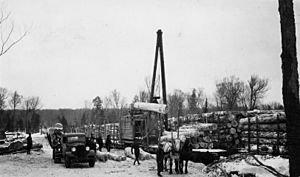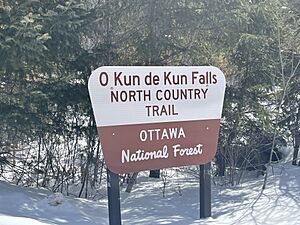Ottawa National Forest facts for kids
Quick facts for kids Ottawa National Forest |
|
|---|---|
|
IUCN Category VI (Managed Resource Protected Area)
|
|
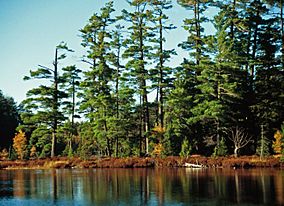
Pinus strobus, Katherine Lake. Ottawa National Forest, Sylvania Wilderness, Michigan
|
|
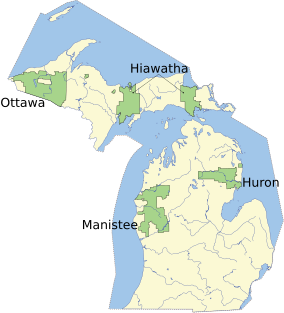
Map showing National Forests in Michigan.
|
|
| Location | Upper Peninsula, Michigan, United States |
| Nearest city | Ironwood, Michigan |
| Area | 993,010 acres (4,020 km2) |
| Established | January 27, 1931 |
| Governing body | U.S. Forest Service |
The Ottawa National Forest is a huge natural area in Michigan, USA. It covers almost a million acres! That's like a giant outdoor playground. This amazing forest is located in the Upper Peninsula of Michigan. It stretches across many counties, including Gogebic and Ontonagon.
The U.S. Forest Service takes care of the Ottawa National Forest. Their main office is in Ironwood, Michigan, right near the Wisconsin border. You can also find a big visitor center in Watersmeet, Michigan. Many towns around the forest are connected by U.S. Highway 2. Local ranger offices are in places like Bessemer and Ontonagon.
Contents
Exploring the Forest's Landscape
Imagine beautiful wooded hills along the south shore of Lake Superior. That's what you'll find in the Ottawa National Forest. This area is known for its stunning natural features.
Waterfalls and Rivers
The Black River is a special river here. It's even called a National Wild and Scenic River. As it flows towards Lake Superior, it creates seven amazing waterfalls. The Presque Isle River also has many waterfalls. Some of these are outside the forest in Porcupine Mountains Wilderness State Park.
High Points and Water Flow
The highest point in the Presque Isle River area is Underwood Hill. It stands at 1,867 feet (569 m) tall. But the very highest spot in the entire forest is an unnamed hill. It's about 1,900 feet (580 m) high. Rain falling on one side of this hill flows to Lake Superior. Rain on the other side travels all the way to the Gulf of Mexico!
Weather and Nature in the Forest
The Ottawa National Forest gets a lot of rain and snow. In winter, it can receive over 200 inches (500 cm) of snow each year! Lake Superior helps create this snow. It usually doesn't freeze, so it adds moisture to the air. In summer, moist air from the distant Gulf of Mexico also brings rain.
Forest Soil and Trees
The land here is rich in water but doesn't have much topsoil. Long ago, during the Ice Ages, giant glaciers scraped away much of the soil. This left behind mostly rock and sand. Because of this, the forest is a special type called a boreal forest.
A Look at the Forest's Past
The Ottawa National Forest has a rich history. It was once home to several groups of the Ojibwa people. They lived among the forest's many rocky wetlands. The Ojibwa hunted animals like beaver for their fur. They traded these furs with people from Canada and the eastern United States.
Land Sales and Logging
After the fur trade slowed down, the Ojibwa sold much of the forest land in 1854. However, some Ojibwa used money from their fur trading to buy land around Lac Vieux Desert. Their families still live there today. Later, around 1892, the forest was opened for logging. Huge white pine and red pine trees were cut down. A few of these old, giant trees still remain today.
Becoming a National Forest
After the logging era ended, parts of the forest were left empty. The U.S. federal government officially created the Ottawa National Forest in 1931. It grew to its largest size in 1935, covering over a million acres. Over time, some land was sold, and the forest reached its current size of about 1.0 million acres. After World War II, more people started visiting the forest thanks to cars and better roads.
Fun Things to Do in the Forest
The Ottawa National Forest is a great place for outdoor adventures! You can go fishing, canoeing, and kayaking on its many lakes. In winter, it's perfect for cross-country skiing and snowmobile riding.
Wilderness Areas
The forest has three special wilderness areas. These are places where nature is protected and left wild. They include the McCormick Wilderness, the Sturgeon River Gorge Wilderness, and the Sylvania Wilderness.
Hiking Trails
The North Country Trail runs right through the forest. Hikers can use this trail to reach beautiful spots like O Kun de Kun Falls.
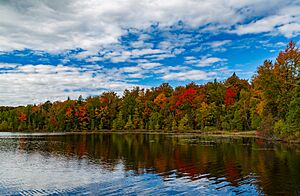
Ottawa Visitor Center
The Ottawa Visitor Center opened in 1971. It teaches visitors about the forest's nature and resources. The center helps people learn how to enjoy the forest safely and respectfully.
See also


